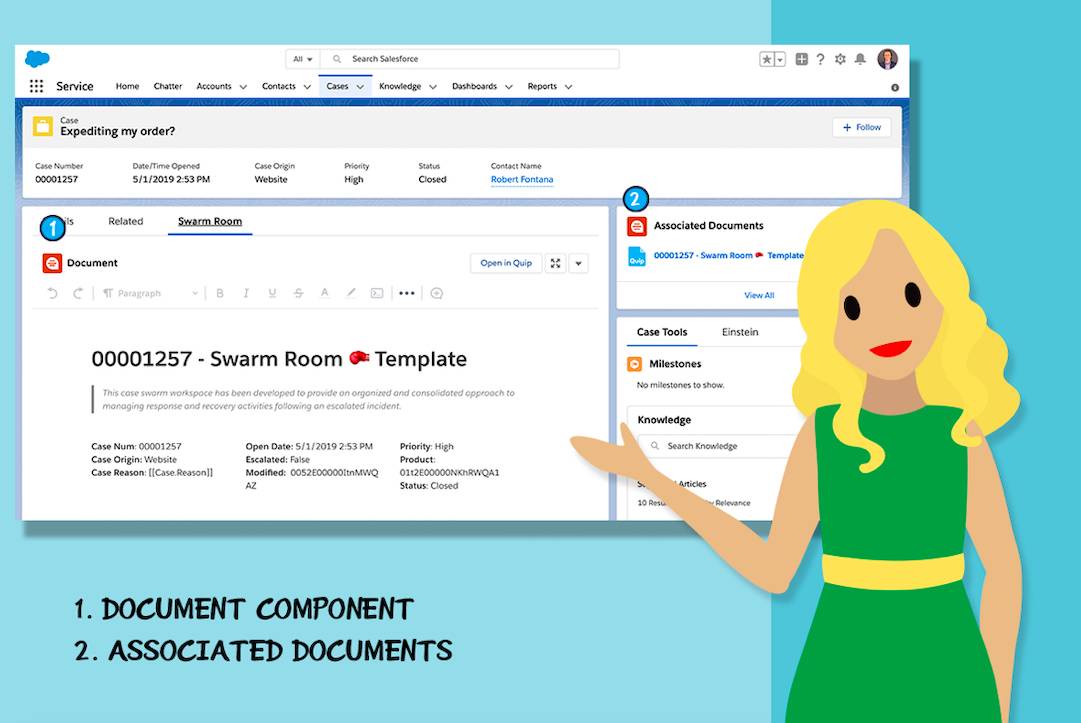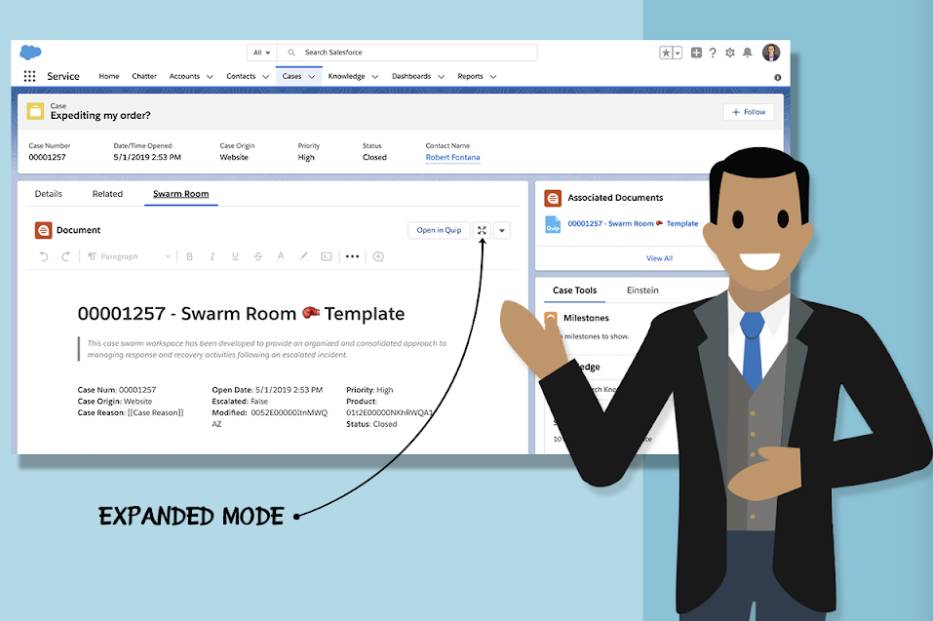Meet Quip Advanced
Learning Objectives
After completing this unit, you’ll be able to:
- Describe Quip for Service Cloud.
- Describe the role Quip for Service Cloud plays as a Service Cloud solution.
- Summarize how Quip for Service Cloud improves job tasks.
- Explain how Quip for Service Cloud helps Service Cloud Customer Service Agents do their jobs better.
Is Quip for Service Cloud, Service Cloud’s Best Kept Secret?
As you know, Service Cloud simplifies automating service processes, streamlining workflows, finding key articles, and locating experts to provide your customers with exceptional customer service.
What you may not know is that Quip for Service Cloud can do all that and more—better and more efficiently than you ever imagined possible.
That’s right. Now you can take everything Service Cloud offers you, your team, and your customers to another level, just by putting Quip for Service Cloud into action.
Imagine that.
What is Quip for Service Cloud, exactly? Glad you asked. However, before we get to that, in case you’re unfamiliar with Quip, here’s what you need to know.
What Quip Is and What Makes It Such an Indispensable Tool?
Quip is a robust, web-based productivity suite that connects a variety of apps and document types into Salesforce, including spreadsheets and documents.

Quip simplifies how you work with folders and links. It helps you cut down on meetings and emails by allowing you to work across all kinds of devices such as mobile phones, laptops, and tablets. It works with any browser and also includes desktop and mobile apps that work on both iOS and Android.
Yes, Quip does all that and so much more—too much more to mention here. In fact, Quip offers users so much creativity, functionality, and advanced technology, it’s like having a productivity wingman at your beck and call.
All that said, what makes Quip really special is that it puts the “team” in “teamwork.”
How? It’s simple. Here are some of the top reasons service teams are working with Quip.
- Get on the same page, at the same time. Quip helps you work with your entire service team on cases, escalations, and more. Every doc has an integrated chat so you can discuss the work right where it’s happening. Imagine your biggest customer reports a bug in your software. Wouldn’t it be great to escalate the case, explain the details, and work with your engineering team all in one place? Now you can!
- Get less email, fewer bottlenecks, and better results. Stop wasting brain power on long email threads and stop wasting your time waiting for the answers you need to close tickets faster. With Quip, you can streamline customer workflows like planning, accessing case records, case routing, and more. So you can spend less time talking and more time completing service requests.
- Get all documents tied to your favorite service console. Now, all of your data can be in one place. Embed Quip's collaborative documents like email, chat, and notes, to work together more productively and efficiently. This comes in handy when you and your team are monitoring cases, case swarms, case escalations, and other service-related requests. And you can do it all directly within Salesforce objects and records, and export Salesforce reports into Quip docs.
Got it? Good.
Now, class, what have you learned thus far?
All together now: You’ve learned that Quip—and teamwork—really do make the dream work.
So, if you’re not yet using Quip to get all things Service Cloud done in your day-to-day work, you’re more than likely working harder and not smarter. And nobody wants that.
Which brings us to Quip for Service Cloud, which we cover next.
Have you got your popcorn ready? No, really. Go for it. You’ve earned it.
Service Cloud User, Meet Quip—for Service Cloud
Now that you’re more familiar with Quip, you’re probably wondering: What is Quip for Service Cloud, and more importantly, what can it do for me?
Quip for Service Cloud applies all the many features and benefits covered previously to work specifically in Service Cloud.
Best of all, Quip for Service Cloud natively integrates into Service Cloud, so it’s made to work within your service console.
On top of all of the amazing things it allows you to do solo, it also makes collaborating with your team a thing of pure beauty. In short, Quip for Service Cloud allows you to take full advantage of everything Service Cloud can do and everything that Quip can do.
But wait, there’s more.
Quip for Service Cloud also empowers you to get more done and make more happen in less time, with a lot less effort—for consistently greater results.
Now, we ask you: What more could you ask for?
Best kept secret, indeed.
Use This Simple Tip to Locate Quip
The best part? Finding Quip in Service Cloud is as easy as finding hay in a haystack. Just locate the logo.
Once you find the Quip logo, it will be sitting next to one of two types of content: a Document Component or an Associated Document. The difference between the two is what you use them to accomplish.
Quip for Service enables you to:
- Swarm cases as a team. Give your team fast access to cross-functional experts without disconnected email or chat storms that live outside your CRM. Satisfy urgent customer needs through real-time collaboration that’s always connected to Service Cloud.
- Capture case knowledge in one place. Reduce the onboarding burden for new agents by having all of the case details, decisions, and case swarming documentation attached to the case in Service Cloud.
- Automate Swarm Docs with CRM context. Standardize and simplify how your teams handle complex cases and customer issues with customizable document templates that fit into existing business process flows. These templates also automatically pull in relevant context from the case record so your agents can focus on the customer instead of data entry.

Once you locate a Quip doc, you can have at it. But remember, you’re going to want to be in Expanded Mode. This enables you to view a larger version of your document and access the associated conversation pane. (More on that later.)
When you click into the embedded document within the Quip Document Component, open Expanded Mode by clicking the button with four arrows in the top right.

Now you know why service agents prize Quip and you also know where to find it. What’s next? It’s time to take everything you’ve learned and put it into action.
Resources
- Webinar: Quip 101: The Foundations
- Video: Collaboration with Quip for Sales
